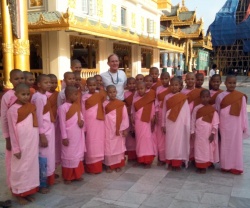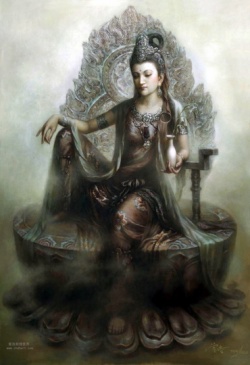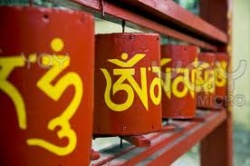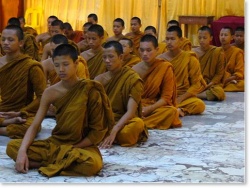A Commentary on the Article Entitled ''Ordinary Mind Is the Way''
By Maha Acarya Yang Fo Xing
(Ordinary Mind Is the Way (Ping Chang Xin Shi Dao) was spoken by Ma Zu – a great Ch’an Master in China. Record of Ma Zu quotes: “The Way needs no cultivation, just do not defile. What is defilement? When with a mind of birth and death one acts in a contrived way, then
everything is defilement. If one wants to know the Way directly: Ordinary Mind Is the Way!”*
The author’s comment: The real state of Ordinary Mind Is the Way is what the Sixth Patriarch Master Hui Neng described as the Samadhi of Specific Mode (Yi Xing San Mei). Only when one has realized the state of Samadhi of Specific Mode in Ch’an practice is he qualified
to say that Ordinary Mind Is the Way.)
A Buddhism Journal in China carried one article entitled “Everyday Mind is the Way”. This article started with the writer’s incorrect assumption that “the Ch’an School was established by the Sixth Patriarch Hui Neng.” One can tell that both the author and the editor
had been careless. However, this mistake has little effect as people with some basic knowledge of Buddhism would know that the author is wrong.
The biggest harm of this article is that the author had misunderstood and misused the words of the Ch’an patriarchs and made arbitrary comment on the Gong An (Koan in Japanese) “Ordinary Mind is the Way”. In his spiritual path Maha Acarya Feng Da An had achieved
accomplishment in the Ch’an practice before attainment of the highest stage of the Esoteric School. He gave the following enlightening instructions on the essence and different stages of Ch’an practice:
“The principle of Ch’an practice is the realization of the innate self-nature; it is with this realization that the practitioner strives to discover his true nature without having to resort to scriptural study. If a practitioner is in the state of instantaneous
realization and with the light of enlightenment illuminated, he has reached the first stage of Ch’an practice (His Gen Shen is thus formed). When in Samadhi, if he doesn’t feel the existence of his physical body and Gen Shen; he has surpassed the second stage. When
the self-nature and its miraculous usage merge in unity and his mind can function without hindrance, he has attained the highest stage of the Ch’an School. In this state all his vexations have been transformed to Bodhi and his life and death turned into Nirvana. He is
in the state of Dharmakaya.
The essence of the Ch’an School corresponds to Prajna Paramita. When the practitioner eradicates both the Internal and External Consciousness, he’s free from any attachment or possession. Having reached this stage, he can see all things in their own essence and his
mind can work without hindarance. This is real Prajna Paramita. Once he has realized the essence of self-nature, he can relate to anyone anywhere appropriately.”
Only when a practitioner had made strenuous efforts in his dedicated practice and has reached the states mentioned above is he qualified to comment on this Gong An. Otherwise, it will be detrimental to both himself and others as the effect has been taken as the cause.
The author wrote in his article: “In the beginning of the history of the Ch’an School, Ch’an masters followed Hui Neng’s teachings and preached the realization of self-nature and reaching Buddhahood through Instantaneous Enlightenment. However, as for Ma Zu, one didn’
t need to realize his self-nature or reach Buddhahood; as long as he can maintain the Ordinary Mind, whatever he does or sees is the Way.”
May I ask the author his grounds for making such arbitrary assumption about Ma Zu?
The Diamond Sutra quotes: “If the Internal and External Consciousness of a practitioner have been eradicated, the true nature of Dharmadhatu will surface. In this state he should feel neither Void nor Non-void and he is completely free from any attachments in the real
sense. Such a state is called Anuttara-Samyak-Sambodhi. Therefore, the Tathagata says all phenomena in the universe are the manifestations of Buddhist Dharma.”
When a practitioner reaches the above-mentioned state, his consciousness has vanished, the true wisdom surfaced and his mind can work freely, then he is qualified to say “whatever he does or sees is the Way.” Or “all the phenomena in the universe are the
manifestations of Buddhist Dharma.” Otherwise, he is only “seeking Bodhi without freeing himself from the arbitrary concepts of phenomena.” He shouldn’t be confused with the two situations.
The author cited another Gong An: “One monk asked Ch’an Master Jing Chen of Chang Sha: “How Can I make Ordinary Mind the Way?” Master Jing Chen replied: “Sleep when you are sleepy and sit down when you want to.” However, this Gong An can only be apprehended correctly
when people associate it with the above-mentioned Dharma teachings. Only then can one say: “Sleep when he is sleepy or sit down as he wants to.” or “Ordinary Mind is the Way.” On the contrary, if one misunderstands and misapplies this Gong An, the bad influences will
be great. For instance, if some sluggards and animals sleep when they are sleepy and sit when they want to, can we describe their action as “Ordinary Mind is the Way”?
Maha Acarya Feng Da An wrote after he had one internal realization as follows: “The power of Krtyanusthana-jnana (Wisdom of perfecting the double work of self-benefit and the benefit of others) can make a practitioner deliver sentient beings in this physical body. His
respect-inspiring deportment should be as follows:
“1. Lying. He sleeps in Samadhi with the Auspicious Reclining Posture.
2. Sitting. He sits up with the back straight in Samadhi either in full-lotus or half-lotus postures.
3. Walking. He walks with his body straight in Samadhi without the idea of motion.
4. Standing. He stands motionless in Samadhi without the concept of stopping.
All other manners are in accordance with the Perfect Enlightenment and beyond the understanding of worldly people.”
These four kinds of deportment of walking, standing, sitting and lying are ordinary actions for mundane people. But accomplished practitioners view them from another angle. Therefore, people without actual practice and internal realization shouldn’t pass judgement
with their deluded mind to avoid making mistakes.
We are now in the Age of the End of Dharma and sentient beings lack both merits and wisdom. There are many people who misunderstand and misapply the Gong An “Ordinary Mind is the Way” just as the author of the article mentioned above did. It’s very important for such
people to contemplate seriously on the teaching “Understanding the wonderful essence of Buddhist Dharma through the literal meaning of Buddha’s words completely distorts the Buddha’s real meanings.”
Note:




